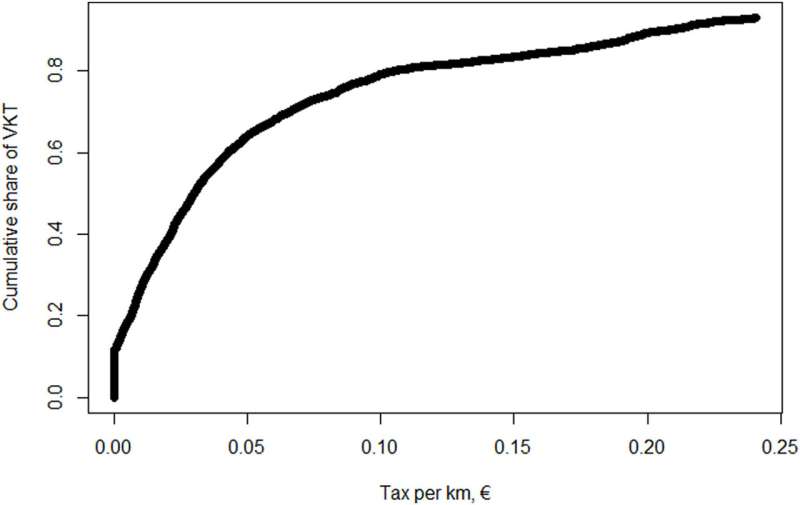
Many of the cars currently speeding through the summer landscape are running on electricity. At the same time, fuel taxes are an important source of income for the government. So where will the money come from in the future when most of the nation’s vehicle fleet has been electrified? Most effective would be increased congestion tax in larger cities. But that raises other questions. This is the conclusion of researchers at Linköping University, Sweden, in a new study.
“In 2040, it may be cheaper to travel by car if you live in the countryside, but in the city it might even be more expensive,” says Maria Börjesson, adjunct professor at the Department of Management and Engineering at Linköping University and professor at the Swedish National Road and Transport Research Institute.
Today, car travel is more heavily taxed than anything else in most industrialized countries. This is partly to finance public expenditure for transport systems and other welfare, and partly to make the individual pay costs that would otherwise fall on society as a whole. These costs include road wear, carbon dioxide emissions and other forms of pollution.
But with more fuel-efficient cars and an increasing number of electric vehicles, the government faces the prospect of a hole in its finances. To remedy this, there is now talk in several countries of introducing a tax per kilometer driven, to be facilitated by monitoring our cars via technical systems. Maria Börjesson believes this is a bad idea, because it would be expensive to check that no one is cheating, and because the costs of carbon dioxide emissions will no longer exist.
In a study published in the journal Transport Policy, the researchers propose a different solution. No matter how cars are driven, they cause congestion at certain places and times. In places that are already congested, this congestion will probably even increase if it becomes cheaper to run vehicles on electricity. The researchers believe it is therefore justifiable to make the individual pay for this through a congestion tax.
In order to investigate how high and how wide the tax needs to be, they have carried out a simulation of the traffic situation on all road sections in a wide area around Stockholm in 2040, when almost all cars are assumed to be electric. The area has four million inhabitants and was chosen because it is made up of both rural areas and cities of different sizes.
The degree of urbanization is similar to that of the Netherlands and the UK. As far as the researchers know, this is the first time that a simulation has been performed over such a large and diverse area.
The simulation shows that the most serious congestion, just like today, occurs at certain times and places around Stockholm and the city of Uppsala, while most road sections have little or no congestion at all. In order to even out traffic flow in 2040, congestion tax must be levied on more routes and also increased significantly at certain times. Today the road toll in Stockholm’s inner city is almost €4 (SEK 45) at peak traffic during peak season. In the future, this could be at least doubled during rush hours.
“It may be most effective to have really high congestion tax during the worst hours, but significantly lower at other times. But, for most road traffic in Sweden, congestion tax is not effective,” says Maria Börjesson.
To cover the non-congestion costs that would otherwise fall on society, such as accidents and wear and tear, a slightly increased vehicle tax may be effective. The researchers’ analysis shows that income from the congestion charge and increased vehicle tax would cover society’s costs for road traffic. If revenue is needed for financing welfare in general, the researchers recommend broader tax bases, such as VAT. But that is a political issue, according to Maria Börjesson.
There are, of course, uncertainties in the simulation, such as economic growth, population development and the cost of buying a car in the future. A potential problem with the researchers’ conclusions is that those living in larger cities may find it unfair if they are made to pay for so much of the cost of the entire road system.
“But that depends on how you look at it. It would benefit those who live in rural areas, but that again is a political issue,” says Maria Börjesson.
More information:
Maria Börjesson et al, Optimal kilometre tax for electric vehicles, Transport Policy (2023). DOI: 10.1016/j.tranpol.2023.01.019
Provided by
The Swedish Research Council
Citation:
Future car travel may be cheaper, but also more expensive (2023, August 7)
retrieved 8 August 2023
from https://techxplore.com/news/2023-08-future-car-cheaper-expensive.html
This document is subject to copyright. Apart from any fair dealing for the purpose of private study or research, no
part may be reproduced without the written permission. The content is provided for information purposes only.
Stay connected with us on social media platform for instant update click here to join our Twitter, & Facebook
We are now on Telegram. Click here to join our channel (@TechiUpdate) and stay updated with the latest Technology headlines.
For all the latest Technology News Click Here
For the latest news and updates, follow us on Google News.
